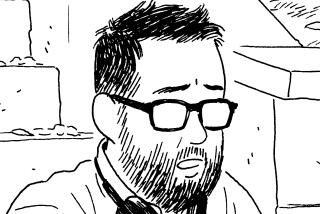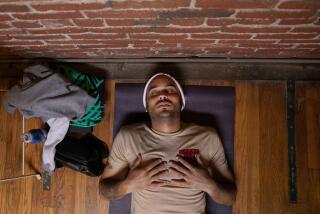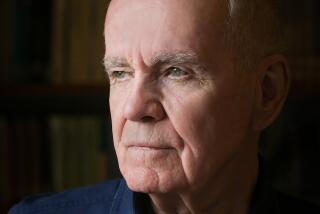Jeffrey Brown’s design for living
- Share via
The most vivid page in Jeffrey Brown’s “A Matter of Life” (Top Shelf Comix: 96 pp., $14.95) – “an autobiographical meditation of fatherhood and faith” in comics form – portrays the artist as a college student, reflecting on existence and its discontents. “Someday,” he tells himself, “I’ll die and then I won’t exist forever and I’ll never have another thought.” The image is followed by eight identical panels of Brown in bed, eyes wide open, overwhelmed by the enormity of the idea.
In a way, it’s a archetypal Brown moment; he’s an artist who likes to work in miniature, often packing a dozen panels on a page. This gives his books – which include “Clumsy” and the transcendent “Funny Misshapen Body” – a kind of obsessive, handmade quality, as if we were looking at a sketchbook; we have no choice but to immerse in the minutiae of his days.
In “A Matter of Life,” that means his experience growing up in a religious household – his father was a minister – and his subsequent lapse (I don’t want to call it a loss, exactly) of faith. “When I was little, I believed in God,” he begins the book. “At least I thought I did. At some point I realized I didn’t believe ... And I hadn’t in a long time ... If ever ... It doesn’t mean I don’t believe in something bigger than myself.”
This is a key conundrum, one I wrestle with myself. How to make sense of a universe in which there’s clearly more than meets the eye, but we can’t understand what it is? For Brown, the solution is to focus on the details, not just in his drawings but in his narrative. “A Matter of Life” is open-ended, less about coming to a conclusion than about framing a set of questions about how to live an engaged life.
At the heart of this are two relationships: one with his father, and the other with his young son, Oscar. The book is dedicated to the two of them, and their presence nicely places Brown in the middle: son and father, child and man.
For Brown, it all comes back to being present, which is highlighted by those small frames, one after the other, cascading across the page. When, late in the book, he helps an older neighbor who has fallen, the crisis takes on the proportions of a mini-epic, 19 separate images across a two-page spread, rendering the encounter as almost unbearably intimate, by turns affirming and sad.
The same could be said of life, of course, or at least that’s the implication – that all of us (Brown, his father, even Oscar) will end up in that old man’s place. What is the point, then? Our reason for living? Maybe just to be there for each other while we can.
“In eight billion years,” Brown writes, “our sun will die ... In one hundred some quintillion years, our whole galaxy will evaporate away.... Every sixty million years of so, most of life on Earth seems to get wiped out. So maybe we just shouldn’t worry so much. In the future, all of this will be the past...”
ALSO:
Steven T. Seagle, Teddy Kristiansen graphic novel probes ‘Genius ...
Miriam Katin’s graphic novel is portrait of an artist’s inner life - Los ...
Rutu Modan’s graphic novel ‘The Property’ journeys through the past ...
More to Read
Sign up for our Book Club newsletter
Get the latest news, events and more from the Los Angeles Times Book Club, and help us get L.A. reading and talking.
You may occasionally receive promotional content from the Los Angeles Times.








